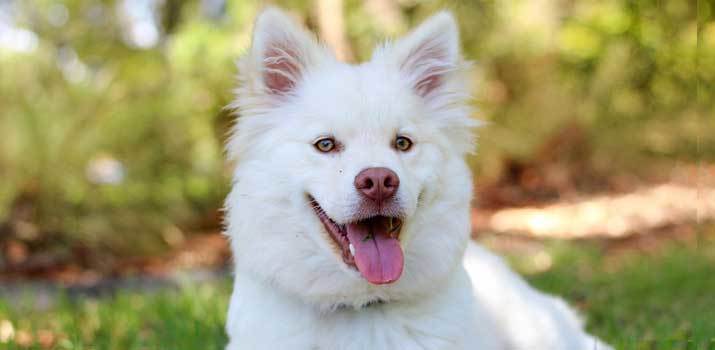
Is there anything cuter than watching a dog flash their pearly white smile with joy? It's a unique sight to behold. While dogs don't smile for the same reasons that we humans do, it's something that many owners love to see.
Training your pup to smile on command is a great party trick that can have everyone gushing over your canine companion. However, it's not as easy as training your dog to sit or stay.
Training your pup to smile takes a lot of dedication. The act of smiling is not something that comes naturally to them.
In most cases, smiling happens by complete coincidence. Luckily, you can teach your dog to understand that smiling is a good thing. With some positive reinforcement, they'll learn to do it just because you love seeing it.
Is It Really Smiling?
Before you start the training process, it's important to understand what canine smiling really is. Generally, the thing that we consider to be smiling is really just relaxed panting.
Your furry friend's teeth may start to show whenever they pant with a slightly open mouth. This is much different than the panting you'll see when your dog is hot or tired. It usually occurs when dogs are in a zen state from a good scratch or belly rub.
Beyond that, there are two other types of canine "smiling."
Submission Smile
As the name would suggest, this smile happens when your dog is trying to show that they're being submissive. This type of smiling should be avoided.

It means that your dog is scared. They see a perceived threat and are trying their best to de-escalate the situation so that they don't get hurt.
This grin will be accompanied by some other physical body cues. Your dog may be sitting or lying on the ground. Their ears will often be pinned back as well, showing that they are fearful.
There's a noticeable difference between a submission smile and a standard smile. Most owners can see the difference immediately, as that relaxed demeanor is replaced with something that looks a bit more awkward and fearful.
Snarling
Another type of smiling you want to avoid is snarling. This happens when dogs are angry and want to assert their dominance. It's the opposite of the submission smile.
While both acts involve showing off teeth, the associated body signals are vastly different. For one, snarling is typically paired with a more aggressive stance.
Your dog may be tense, putting all of their body weight forward just in case they need to pounce on a would-be attacker. Their ears will also be upright and pointed in the direction of the threat. Your dog's tail will also be standing up and still.
It's important that you don't teach your dog to do these types of smiles. The last thing you want to be doing is making your dog feel uncomfortable. Smiling should be about joy and relaxation, so if you notice any of these smiles during the training process, you may want to reevaluate your techniques.
How to Train Your Dog to Smile
There are a few different ways that you can teach your pup to smile. Some owners prefer to do it with voice commands while others like the simplicity of a clicker. There are even a couple of different ways to get your pup to show their smile.
Basic Technique
This method is the easiest. It involves pulling your dog's lips up to initiate the smile and rewarding them for a job well done. It's best to do this when your dog is already in a happy-go-lucky mood. Start by giving them a nice belly rub or head scratch.

Then, use your thumb and middle finger of one hand to lift your dog's lip up from above. After you do this, say "smile," and give them a treat.
It's important that you do this in short bursts. If your dog looks like they're getting frustrated, give it a rest and try again another time.
Eventually, your dog will start to associate that your verbal command, "smile," with a treat. You can then give the command without pulling up your dog's lips with your own hand.
Tickle Method
If you want your dog to have a quirkier smile, you can try the tickle method. Instead of pulling up your dog's lips on your own, you'll be tickling their snout to promote a natural lip curl.
What results is often a silly little smile that your dog can learn to do on their own.
When your dog is calm and happy, just tickle his or her snout with your fingers. You can tickle the whiskers on just one side. Then, immediately give your verbal command.
If you're using a clicker, you can give your pattern command. When your pup curls their lip for a smile, give them a treat and plenty of positive reinforcement. It's a good idea to say things like, "Good Smile!" Joyous praise will teach them to love training.
Slowly, but surely, you should start to phase out the tickling. Simply give your command and see how your dog reacts. If they give off that signature smile, reward them for a job well done.
Training Tips
This type of training is very different from standard housebreaking or obedience training. Because it's not something that comes naturally to them, it can get a bit confusing.
Here are some tips to make the process go as smoothly as possible.
Keep Things Fun

Smiling is not that serious, so you shouldn't be treating the training process as if it were some major thing. It won't be the end of the world if your dog doesn't get it right away.
Keep things light and fun to ensure that your pup enjoys their lessons.
Dogs are much more inclined to absorb your training if they are in a positive mind space. Try to surround the training with some extra play time.
Let your dog use their favorite toy or take them out on a walk once they do a good job.
Keep Your Lessons Short
Your training sessions should not last more than 10 minutes. Dogs have short attention spans. Repeatedly doing the same thing over and over again will get boring. They may start to lose focus.
If your dog isn't getting things right away, take a breather. Play around with them for a bit and try again later.
Remain Patient
Not all dogs are going to pick up training techniques in a few sessions. Teaching your pup to smile can take several months. It all depends on your pup's ability to pick up new skills.
Avoid getting frustrated and stay vigilant.
Always use positive reinforcement. You should never hit your dog or yell at them. This will only make things more difficult. Eventually, your furry pal will get the hang of things.
Conclusion
Smiling on command is a pretty advanced skill that most owners don't even attempt to teach. As a result, your dog will be the center of attention once they have this trick on lock.
If you stay persistence and make the training process as fun as possible for your dog, you're bound to see success.
Also read:

